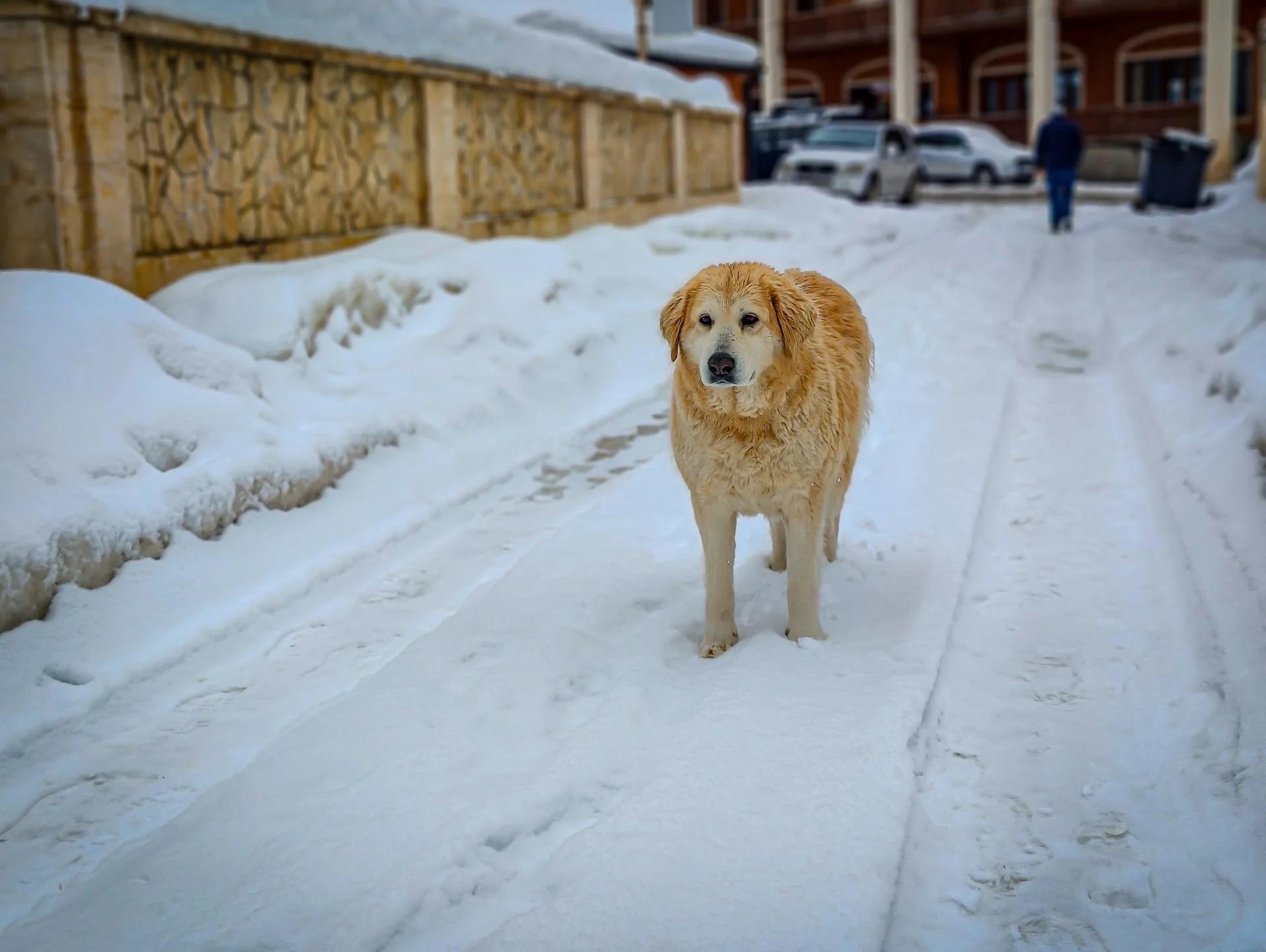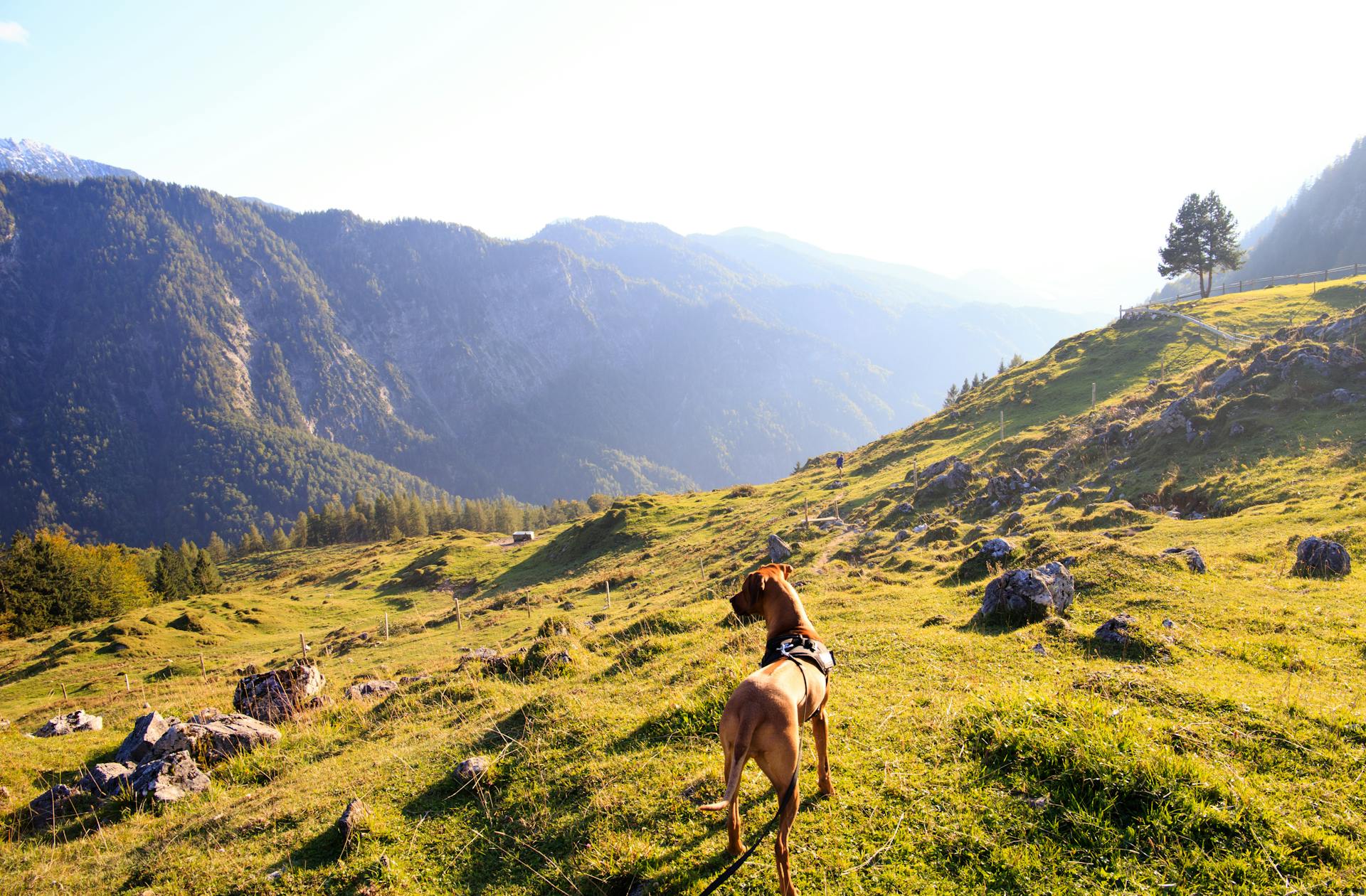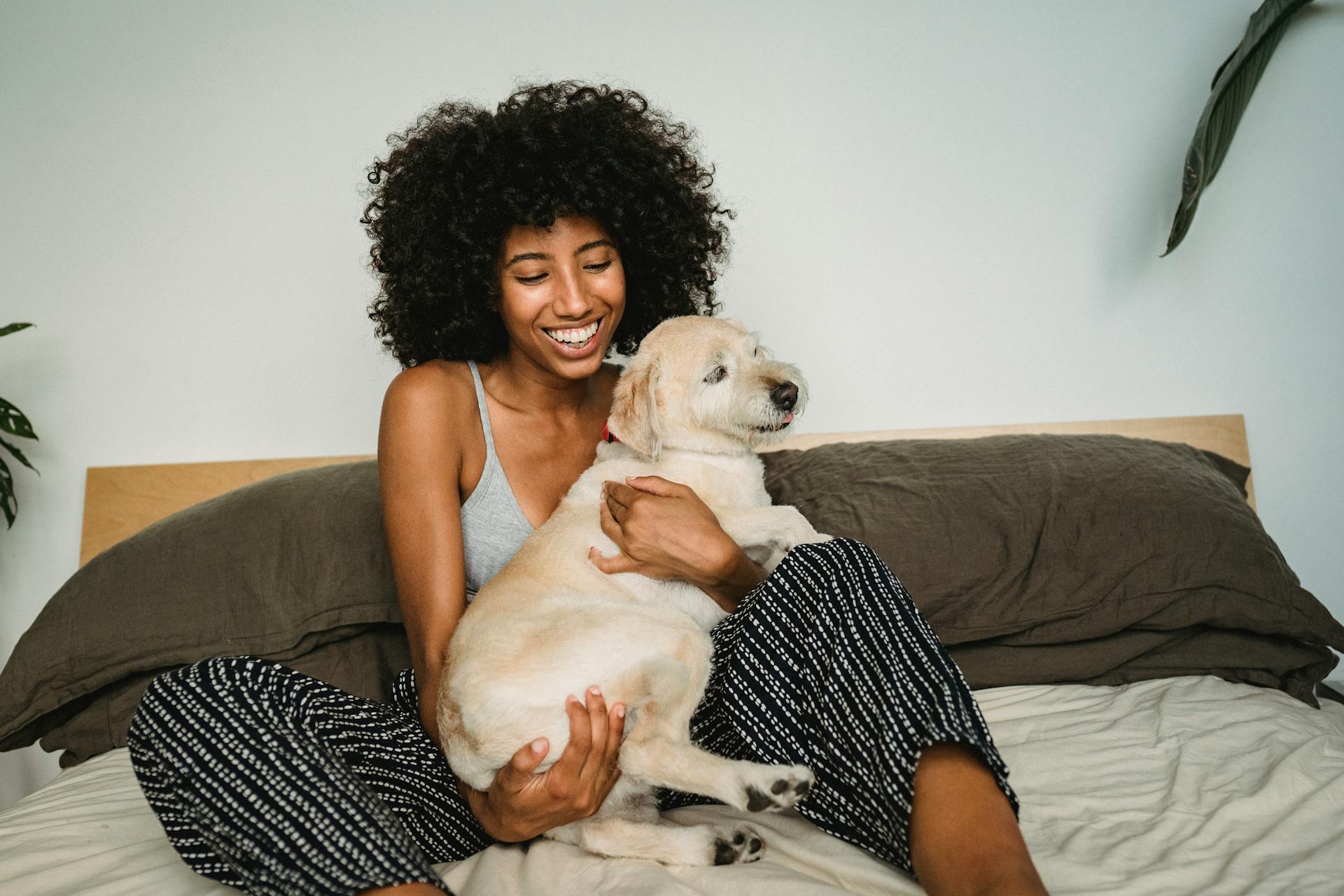
Keeping your Great Pyrenees on property is crucial, and it's not just about physical barriers. A well-trained dog is essential to prevent escapes.
To start, it's essential to understand that Great Pyrenees are naturally inclined to roam and protect their territory, which can sometimes lead to unwanted excursions. They require regular exercise and mental stimulation to keep them occupied.
A secure fence is a must-have to prevent escapes. According to our article, a fence should be at least 6 feet tall to prevent jumping, and it's recommended to extend the fence 12-18 inches below ground to prevent digging.
Regular training and socialization are also vital to keep your Great Pyrenees on property. They need to learn basic obedience commands and be desensitized to potential distractions that might trigger an escape attempt.
Intriguing read: How to Keep Livestock Guardian Dogs from Roaming
Understanding Great Pyrenees
The Great Pyrenees is a gentle dog, but he's still a guard dog at heart, and socialization and training are required to ensure he's a well-behaved companion.
They're known for their independent nature and aloofness around strangers, but they have a strong love for children and are tolerant and nurturing with young animals.
A Great Pyrenees will protect his charges, but he's not aggressive, making him an excellent choice for new owners of livestock guardian dogs.
They're natural barkers, especially at night, and have a strong urge to expand their territory, which can result in roaming if not properly contained by fencing.
If you're considering a Great Pyrenees as a companion dog, look for breeders who specialize in livestock guardians or pay attention to good guardian qualities in their breeding choices.
Some dogs may be bred primarily for show or companionship and lack proper working temperament, so it's essential to ask the right questions when searching for a breeder.
Many Great Pyrenees are turned over to rescue efforts due to barking, overprotectiveness, shedding, digging, and the inability to keep the dog contained, so make sure you're prepared to provide the necessary care and attention.
Related reading: Why Do Great Pyrenees Bark so Much
Coat Care and Grooming
Great Pyrenees have a thick coat that needs to be taken care of properly. This coat is essential for their protection from the sun and insulation.
Don't even think about clipping or shearing your Great Pyrenees' coat, as it can lead to poor coat quality. Instead, you'll need to groom them regularly to prevent matting and dirt retention.
If your dog has a soft, "cottony" coat, be prepared for frequent grooming sessions.
You might enjoy: Great Pyrenees Coat Colors
Appearance
The Pyrenees breed has a distinctive appearance that's worth noting. The ideal GP head resembles the Pyrenees brown bear, with very little stop between the muzzle and head.
Their almond-shaped dark eyes are described as "kindly" and are a key feature of the breed. The small to medium ears are carried low and close to the head.
The breed standard specifically warns against a mastiff-like appearance with heavy flews, a blunt muzzle, or a dewlap. The plumed tail is carried low unless alert, when it can form a wheel over the back.
Here's an interesting read: Grazing Muzzle for Horse
The Pyr's double coat is a defining characteristic, making them appear larger than they are. The long outer coat should be weather resistant and shed dried mud.
Working dogs in the Pyrenees can appear taller in the leg, with less coat than the dogs seen in the show ring and homes.
For your interest: When Do Great Pyrenees Get Their Full Coat
Coat Care
Great Pyrenees have a unique coat that needs special care. It's essential to avoid clipping or shearing their coat, as it provides protection from the sun and insulation.
The harsh outer coat is crucial for a working Pyr's health and well-being. Unfortunately, many working-dog Pyrenees have soft "cottony" coats instead.
Frequent grooming is a must for dogs with cottony coats, as they mat, attract foreign matter, and retain dirt easily. This can be a challenge for owners, but regular grooming can help prevent these issues.
Don't expect a working Pyr to have a show-quality coat, as their coats are often prioritized for function over form.
See what others are reading: How Do You Groom a Great Pyrenees
Training and Behavior
To keep your Great Pyrenees on property, training and behavior are key. Teach your dog a range of basic commands, such as ‘sit’ and ‘stay’, to channel their energy into something productive.
Positive reinforcement is a powerful method for dog training, where your dog is rewarded for desired behaviors with treats, praise, or toys, depending on their preferences. This encourages them to repeat those actions in the future.
Effective communication is crucial to establish a foundation of understanding and respect between you and your dog. Provide clear and consistent instructions, and ensure there are consequences for not following through.
Develop a consistent training routine and create positive habits by having a training schedule at the same time every day for the same amount of time. This will help your dog understand what's expected of them.
As your dog masters staying in the yard in your presence, it's time to add in some triggers to challenge them. Start with a family member making noise or moving around on the other side of the fence, and work on training with this trigger.
Fencing and Containment
Fencing can be an effective way to keep your Great Pyrenees on property, but it's essential to choose the right type of fencing. Great Pyrenees and other Large Guardian Dogs (LGDs) are athletic and can jump very tall fences, so you'll need to consider a fence that's at least 6 feet high to prevent them from jumping over. If your dog can find a place on the fence to stick their paws, they will climb over effortlessly.
Obscuring their view can also help remove the temptation for your dog to escape. You can do this by adding fencing or bushes to block their line of sight. This can be especially helpful if your dog is a close-guarding breed, like the Spanish Mastiff, which tends to respect fences more than roaming breeds.
To create a secure fence, you can also consider using wire at the bottom of the fence to prevent your dog from digging under. You can dig down into the ground and place the wire down, then cover it back over with dirt. This will deter your dog from digging under the fence.
Suggestion: Will a Great Pyrenees Attack an Intruder
Defining Tasks
Training your Great Pyrenees to stay in your yard is much easier than many people realize.
You'll need to take a number of steps to deter them from leaving the yard in the first place.
The good news is that you can see results in just a week or so if your dog is a puppy.
However, if they're older, stubborn, and with a lifetime of running away under their collar, then you may need a month or two.
Intriguing read: Great Pyrenees Exercise
Great Pyrenees
The Great Pyrenees is a breed that requires careful consideration when it comes to fencing and containment.
Their strong urge to expand their territory can result in roaming if not properly contained by fencing.
These dogs are known to be excellent at barking and warning threats, but may become overprotective if not socialized and trained properly.
A Great Pyrenees needs a secure and sturdy fence to prevent escape and unwanted roaming.
Their independent nature means they may not respond well to verbal commands, making physical containment a crucial aspect of their care.
The ideal fence for a Great Pyrenees should be at least 6 feet tall and made of durable materials to prevent digging and climbing.
With proper fencing and containment, a Great Pyrenees can thrive as a loyal and loving companion.
Their calm demeanor and gentle nature make them an excellent choice for families with children, but still require careful consideration when it comes to fencing and containment.
Fencing and Containment
If you're a Great Pyrenees owner, you know how important it is to keep them safe and secure in their yard. Unfortunately, these dogs are notorious for jumping over fences, and some breeds can even clear 6-foot tall fences with ease.
To prevent your Great Pyrenees from jumping over the fence, you'll need to install a fence that's at least 6 feet tall. However, even with a tall fence, some dogs may still find a way to climb over by sticking their paws on the fence and pulling themselves up.
Explore further: Do Great Pyrenees Have 6 Toes
One way to prevent this is to dig down into the ground at the bottom of the fence and place a wire, such as chicken wire or woven wire, to deter them from digging under.
Here are some tips to help you choose the right fence for your Great Pyrenees:
- Consider a fence that's at least 6 feet tall to prevent jumping.
- Use a wire at the bottom of the fence to prevent digging.
- Consider using a GPS dog fence, such as SpotOn, which allows you to create custom fences and track your dog's location without cell service.
By following these tips, you can help keep your Great Pyrenees safe and secure in their yard.
Outdoor Management
To keep Great Pyrenees on property, outdoor management is crucial. This includes establishing clear boundaries and using physical barriers such as fencing to prevent escape.
A single strand of barbed wire is not enough to contain a Great Pyrenees, requiring a minimum of 3 strands of high-tensile wire to prevent escape.
Regular inspections of the fencing and property perimeter are essential to ensure the integrity of the enclosure and prevent any potential escape routes.
Getting Started
To get started with outdoor management, you'll need a long leash to keep your furry friend safe while exploring the yard.
A secure fencing is a must-have to prevent escape attempts.
You'll also need some engaging toys to keep your pet entertained during outdoor time.
Food puzzles will challenge your pet's problem-solving skills and keep them occupied.
A decent stockpile of treats is essential for rewarding good behavior and keeping your pet motivated.
Breaking your pet's favorite food into small pieces can be a tasty alternative to treats.
Set aside 10 minutes each day for training to help your pet learn and grow.
Constant access to the yard is crucial for your pet's physical and mental well-being.
Worth a look: Great Pyrenees Dog Food
Outdoor Shelter
An outdoor shelter is a must-have for your furry friend. Fido needs to have somewhere safe and secure they can sleep in at night.
You can buy or make an outdoor shelter, but it will give your dog a sense of ownership and a place to escape to when the weather is bad.
Why Customers Chose SpotOn
If you're like many Great Pyrenees owners, you're looking for a reliable way to keep your dogs safe and contained on your property. SpotOn is a great solution for LGDs (Livestock Guard Dogs) like Great Pyrenees.
One reason SpotOn stands out is that it allows you to create custom fences that can cover large areas, up to 100,000+ acres. This is especially useful for ranchers and farmers who need to protect their property and livestock.
SpotOn fences can be designed to follow unusual property lines and navigate through tricky terrain, including water, rocks, and heavy brush. This means you can create a safe and effective boundary for your dogs without having to install hardware or dig trenches.
SpotOn also offers the flexibility to create up to 20 fences for rotational grazing, which can be especially helpful for herding dogs like Great Pyrenees. This allows you to keep your dogs close to their herd and prevent them from wandering off.
Here are some of the key benefits of SpotOn:
- Create custom fences from ½ acre to 100,000+ acres.
- No hardware to install and no trenches to dig.
- Create, save and edit GPS dog fences wherever and whenever you need them.
- No cell service required to contain your dog with GPS fences.
- Create up to 20 fences for rotational grazing.
Many customers have reported that SpotOn has made a huge difference in their lives, giving them peace of mind and allowing their dogs to roam freely and safely. As one satisfied customer put it, "Now they have the freedom they need to roam and guard their herd, and they’ve finally learned to stay home, respecting their GPS boundaries."
Training Q&A
Training your Great Pyrenees to stay on property requires patience and consistency.
To start, Great Pyrenees are naturally inclined to roam and patrol their territory, which can sometimes get them into trouble.
You'll want to establish a clear boundary and make sure your dog knows what's expected of them.
According to the article, a 4-6 foot high fence is recommended to prevent your Great Pyrenees from jumping over.
Your dog should also be trained to respond to basic commands like "stay" and "come".
In fact, the article suggests that training should begin at a young age, ideally between 8 and 12 weeks old.
Frequently Asked Questions
How do I stop my Great Pyrenees from digging?
Preventing digging starts with supervision and identifying high-risk areas in your yard, such as loose dirt or damp spots. Supervise your Great Pyrenees and modify the yard to minimize digging opportunities.
Sources
- https://www.grit.com/animals/pets/great-pyrenees-ze0z1702zfis/
- https://spotonfence.com/pages/fence-training-your-livestock-guardian-dog-spoton-fence
- https://www.forloveoflivestock.com/blog/the-great-escape-artist-pyrenees-how-to-keep-your-pyr-in-the-yard-or-pasture
- http://www.milkandhoneyfarm.com/dogs/training.html
- https://wagwalking.com/training/train-a-great-pyrenees-to-stay-in-yard
Featured Images: pexels.com


